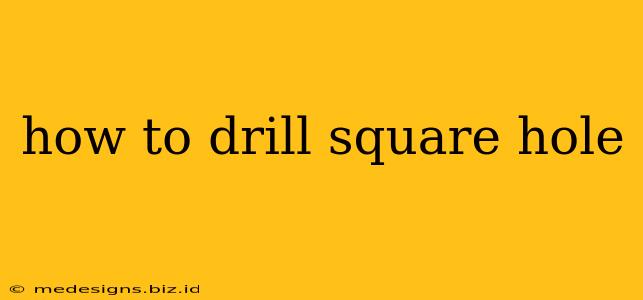Drilling a square hole might sound like a niche skill, but it's surprisingly useful in various applications, from woodworking and metalworking to creating unique designs. While you can't achieve a perfect square with a single drill bit, there are several effective methods to get remarkably square results. This guide explores the most common techniques, offering step-by-step instructions and tips for success.
Understanding the Challenges of Drilling Square Holes
Unlike round holes, which are easily created with standard drill bits, square holes require more specialized approaches. The inherent challenge lies in the corners; standard drill bits simply can't create those sharp 90-degree angles. This is why we rely on clever workarounds and specialized tools.
Why You Might Need a Square Hole
Before diving into the techniques, let's consider why someone would even want a square hole. Several applications benefit from this unusual shape:
- Woodworking: Creating mortises for joinery, crafting unique decorative elements, and designing custom-shaped boxes.
- Metalworking: Machining specific parts, creating ventilation or drainage systems with precise square openings, and crafting intricate metal designs.
- Unique Projects: Designing custom furniture, building intricate models, or creating specialized tools.
Methods for Drilling Square Holes
There are several ways to achieve the desired result, each with its own set of tools and techniques:
1. Using a Square Drill Bit (Rotary File):
This is perhaps the simplest and most direct method, though the results might not always be perfectly square depending on the quality and sharpness of the bit.
- What you'll need: A square drill bit (often called a rotary file), a drill press (recommended for accuracy), and appropriate safety gear (safety glasses).
- How to do it: Secure your workpiece firmly. Use the drill press to maintain even pressure and speed. Start slowly, gradually increasing the speed as the bit cuts into the material. Multiple passes might be needed to achieve the desired depth.
Advantages: Relatively straightforward for beginners. Disadvantages: Can be expensive, may leave slightly rounded corners, limited size availability.
2. The "Rotozip" Method:
A Rotozip tool, or similar rotary cutting tool, offers more control and precision, especially in harder materials.
- What you'll need: A Rotozip tool, square cutting bits (various sizes), a guide (optional, for increased precision), and safety equipment.
- How to do it: Carefully guide the Rotozip bit along the marked lines. Multiple passes might be needed, especially for deeper holes. A guide template will enhance accuracy.
Advantages: High precision, works on various materials. Disadvantages: Requires more skill, can be more time-consuming.
3. Chiseling and Drilling Method:
For larger square holes, this traditional method can be surprisingly effective.
- What you'll need: A drill bit slightly smaller than the desired square's width, a chisel, a hammer, and a marking tool.
- How to do it: Drill four pilot holes at the corners of your marked square. Carefully chip away the material between the pilot holes using the chisel, maintaining square corners as much as possible. This method takes practice and patience.
Advantages: Can be used with readily available tools, appropriate for large holes. Disadvantages: Requires more skill, time-consuming, may result in less precise holes.
4. Using a Specialized Square Hole Punch:
For repetitive tasks or specific material types, dedicated square hole punches are available.
- What you'll need: A square hole punch (specific for the material you're working with), a hammer, and a sturdy surface.
- How to do it: Position the punch carefully, ensuring it's aligned correctly. Strike the punch firmly with the hammer.
Advantages: Efficient for repeated cuts, clean and accurate. Disadvantages: Specific tool required for each size and material, limited size range.
Tips for Success
- Mark Accurately: Precise marking is crucial for achieving square results. Use a ruler and a sharp pencil or marker.
- Secure Your Workpiece: A stable workpiece is essential to prevent slippage and accidents. Use clamps or a vise as needed.
- Start Slowly: Avoid forcing the bit. Let the tool do the work to prevent damage or injury.
- Multiple Passes: Multiple passes often produce cleaner and more accurate results.
- Sharpen Your Tools: Sharp bits are essential for clean cuts and minimize the chances of tear-out.
By carefully following these methods and tips, you can successfully drill square holes, adding a unique element to your projects and showcasing your skills. Remember safety first! Always wear appropriate protective gear.
